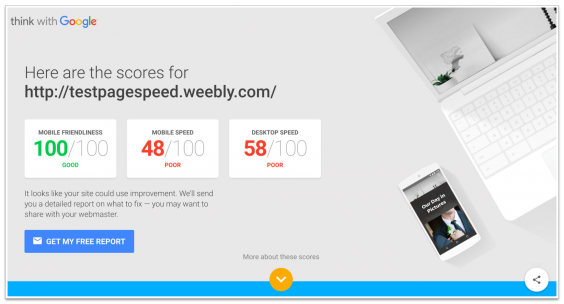We are in the golden age of mobile. Nearly every person in this world uses a mobile device when looking for information online. For this reason, small- and medium-sized businesses (SMBs) have catered to the needs and behaviors of these mobile users worldwide to ensure satisfying, positive experiences. In fact, Google gives a mobile-friendly site a boost in search engine ranking in relation to its recent algorithm update.
But once an SMB has gained a competitive advantage by making its website mobile-friendly, what should be next?
Page speed and why it matters
Page speed refers to the time it takes a specific web page to display its content -- text, images and more.
Google uses a point-based system that ranges from 0-100 that considers two main components of page speed: time to above-the-fold load and time to full page load.
When optimized, page speed can work wonders for your brand -- no matter what your business goals are. Fast loading sites, in general, receive 25% more views in ads, lower bounce rates and better reputations. Best of all, users stay longer.
That's why your page speed directly affects your sales and conversions. The faster your web page, the more revenue you’ll make.
Optimizing for speed
The first step to optimizing a website's speed is to analyze its current performance. Then, after confirming a slow loading time, SMBs can get started with speeding up their sites by optimizing images, minifying code and using a caching system.
One excellent solution to guarantee fast website speed is to use a site builder that’s pre-designed with speed in mind. That way, you don't have to optimize page speed yourself, which can take a lot of time and effort.
To date, there are known website builders that vary in speed performance, including Squarespace, WordPress, Weebly, Wix and Duda.
How fast is fast?
Google aims for a minimum speed of less than half a second. However, they have set the threshold to 2 seconds. Beyond 2 seconds, your site can be considered slow.
Because the most practical solution to building speed is starting with a platform that has already been tightly optimized, we need to look at the actual Google PageSpeed Insights test results of the abovementioned leading selected website builders in the market.
1. WordPress
WordPress scored 62/100 on mobile and 83/100 on the desktop. The test was based on WordPress’ first theme (Edin) for businesses.

2. Weebly
Weebly scored 48/100 on mobile and 58/100 on the desktop. The test was based on Weebly’s LoveSeat theme.

3. Wix
Wix scored 48/100 on mobile and 71/100 on the desktop. The test was based on its Barista theme.

4. Duda
Duda scored 91/100 on mobile and 97/100 on the desktop. The test was based on one of Duda’s websites. Among the four, Duda had the highest score on speed performance.

Selling speed to your customers
Small and medium-sized business have accepted mobile optimization and have therefore followed the best practices to gain loyal customers. The next critical ranking factor to capitalize on is page speed. While brands can tap into methods to speed up their sites, building their online businesses from the ground up while using a platform that’s designed to the latest speed advancements puts them far ahead of the curve.
Customers are making quick judgments about you the moment they arrive at your site. A few seconds of delay creates a strong negative impression.
Conclusion
Page speed is a critical element that online businesses cannot shove aside. Make your customers’ web experiences hassle-free and worthwhile. Don’t give them a reason to choose competitors simply because you failed to optimize for speed. Using a platform built for speed is the most sensible way for you to guarantee higher conversions, a better Google ranking, and top-notch customer satisfaction.
Source: Entrepreneur
